Akio Hayakawa
SoundReactor: Frame-level Online Video-to-Audio Generation
Oct 02, 2025



Abstract:Prevailing Video-to-Audio (V2A) generation models operate offline, assuming an entire video sequence or chunks of frames are available beforehand. This critically limits their use in interactive applications such as live content creation and emerging generative world models. To address this gap, we introduce the novel task of frame-level online V2A generation, where a model autoregressively generates audio from video without access to future video frames. Furthermore, we propose SoundReactor, which, to the best of our knowledge, is the first simple yet effective framework explicitly tailored for this task. Our design enforces end-to-end causality and targets low per-frame latency with audio-visual synchronization. Our model's backbone is a decoder-only causal transformer over continuous audio latents. For vision conditioning, it leverages grid (patch) features extracted from the smallest variant of the DINOv2 vision encoder, which are aggregated into a single token per frame to maintain end-to-end causality and efficiency. The model is trained through a diffusion pre-training followed by consistency fine-tuning to accelerate the diffusion head decoding. On a benchmark of diverse gameplay videos from AAA titles, our model successfully generates semantically and temporally aligned, high-quality full-band stereo audio, validated by both objective and human evaluations. Furthermore, our model achieves low per-frame waveform-level latency (26.3ms with the head NFE=1, 31.5ms with NFE=4) on 30FPS, 480p videos using a single H100. Demo samples are available at https://koichi-saito-sony.github.io/soundreactor/.
TITAN-Guide: Taming Inference-Time AligNment for Guided Text-to-Video Diffusion Models
Aug 01, 2025Abstract:In the recent development of conditional diffusion models still require heavy supervised fine-tuning for performing control on a category of tasks. Training-free conditioning via guidance with off-the-shelf models is a favorable alternative to avoid further fine-tuning on the base model. However, the existing training-free guidance frameworks either have heavy memory requirements or offer sub-optimal control due to rough estimation. These shortcomings limit the applicability to control diffusion models that require intense computation, such as Text-to-Video (T2V) diffusion models. In this work, we propose Taming Inference Time Alignment for Guided Text-to-Video Diffusion Model, so-called TITAN-Guide, which overcomes memory space issues, and provides more optimal control in the guidance process compared to the counterparts. In particular, we develop an efficient method for optimizing diffusion latents without backpropagation from a discriminative guiding model. In particular, we study forward gradient descents for guided diffusion tasks with various options on directional directives. In our experiments, we demonstrate the effectiveness of our approach in efficiently managing memory during latent optimization, while previous methods fall short. Our proposed approach not only minimizes memory requirements but also significantly enhances T2V performance across a range of diffusion guidance benchmarks. Code, models, and demo are available at https://titanguide.github.io.
Step-by-Step Video-to-Audio Synthesis via Negative Audio Guidance
Jun 26, 2025Abstract:We propose a novel step-by-step video-to-audio generation method that sequentially produces individual audio tracks, each corresponding to a specific sound event in the video. Our approach mirrors traditional Foley workflows, aiming to capture all sound events induced by a given video comprehensively. Each generation step is formulated as a guided video-to-audio synthesis task, conditioned on a target text prompt and previously generated audio tracks. This design is inspired by the idea of concept negation from prior compositional generation frameworks. To enable this guided generation, we introduce a training framework that leverages pre-trained video-to-audio models and eliminates the need for specialized paired datasets, allowing training on more accessible data. Experimental results demonstrate that our method generates multiple semantically distinct audio tracks for a single input video, leading to higher-quality composite audio synthesis than existing baselines.
Taming Multimodal Joint Training for High-Quality Video-to-Audio Synthesis
Dec 19, 2024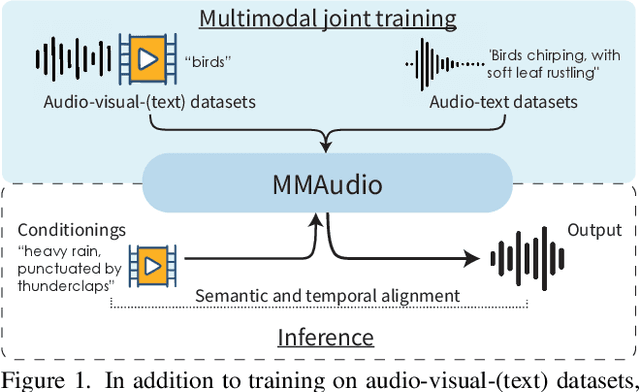
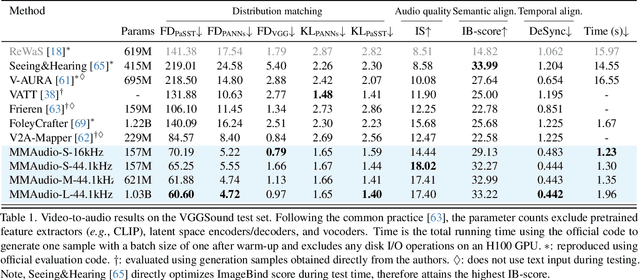
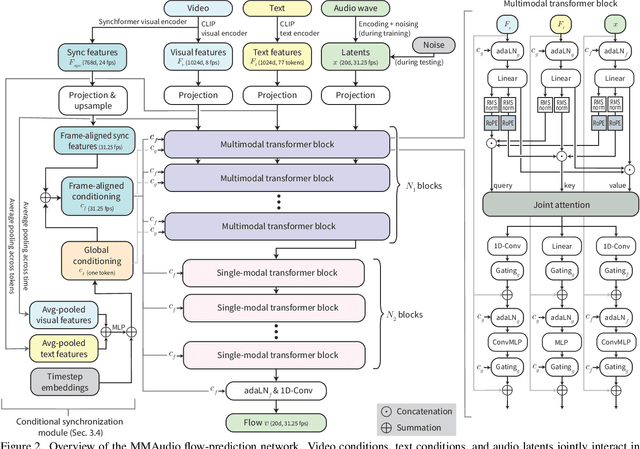
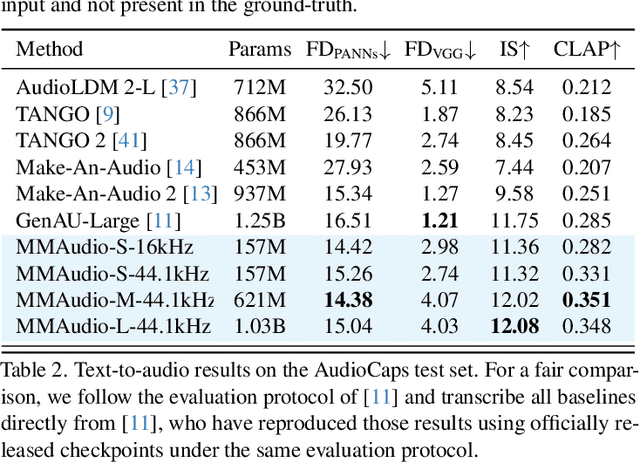
Abstract:We propose to synthesize high-quality and synchronized audio, given video and optional text conditions, using a novel multimodal joint training framework MMAudio. In contrast to single-modality training conditioned on (limited) video data only, MMAudio is jointly trained with larger-scale, readily available text-audio data to learn to generate semantically aligned high-quality audio samples. Additionally, we improve audio-visual synchrony with a conditional synchronization module that aligns video conditions with audio latents at the frame level. Trained with a flow matching objective, MMAudio achieves new video-to-audio state-of-the-art among public models in terms of audio quality, semantic alignment, and audio-visual synchronization, while having a low inference time (1.23s to generate an 8s clip) and just 157M parameters. MMAudio also achieves surprisingly competitive performance in text-to-audio generation, showing that joint training does not hinder single-modality performance. Code and demo are available at: https://hkchengrex.github.io/MMAudio
Difficult for Whom? A Study of Japanese Lexical Complexity
Oct 24, 2024Abstract:The tasks of lexical complexity prediction (LCP) and complex word identification (CWI) commonly presuppose that difficult to understand words are shared by the target population. Meanwhile, personalization methods have also been proposed to adapt models to individual needs. We verify that a recent Japanese LCP dataset is representative of its target population by partially replicating the annotation. By another reannotation we show that native Chinese speakers perceive the complexity differently due to Sino-Japanese vocabulary. To explore the possibilities of personalization, we compare competitive baselines trained on the group mean ratings and individual ratings in terms of performance for an individual. We show that the model trained on a group mean performs similarly to an individual model in the CWI task, while achieving good LCP performance for an individual is difficult. We also experiment with adapting a finetuned BERT model, which results only in marginal improvements across all settings.
A Simple but Strong Baseline for Sounding Video Generation: Effective Adaptation of Audio and Video Diffusion Models for Joint Generation
Sep 26, 2024



Abstract:In this work, we build a simple but strong baseline for sounding video generation. Given base diffusion models for audio and video, we integrate them with additional modules into a single model and train it to make the model jointly generate audio and video. To enhance alignment between audio-video pairs, we introduce two novel mechanisms in our model. The first one is timestep adjustment, which provides different timestep information to each base model. It is designed to align how samples are generated along with timesteps across modalities. The second one is a new design of the additional modules, termed Cross-Modal Conditioning as Positional Encoding (CMC-PE). In CMC-PE, cross-modal information is embedded as if it represents temporal position information, and the embeddings are fed into the model like positional encoding. Compared with the popular cross-attention mechanism, CMC-PE provides a better inductive bias for temporal alignment in the generated data. Experimental results validate the effectiveness of the two newly introduced mechanisms and also demonstrate that our method outperforms existing methods.
Discriminator-Guided Cooperative Diffusion for Joint Audio and Video Generation
May 28, 2024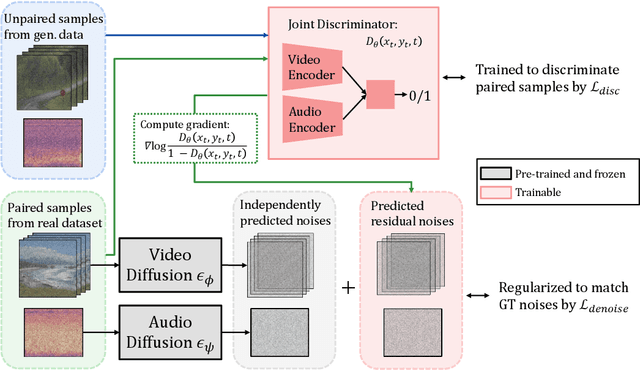
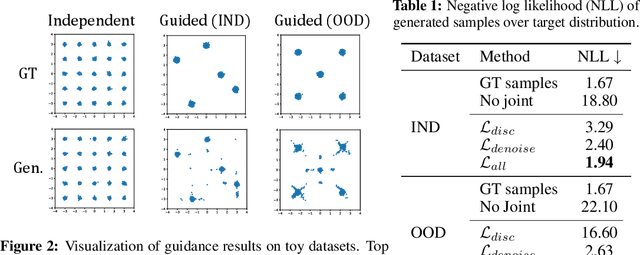

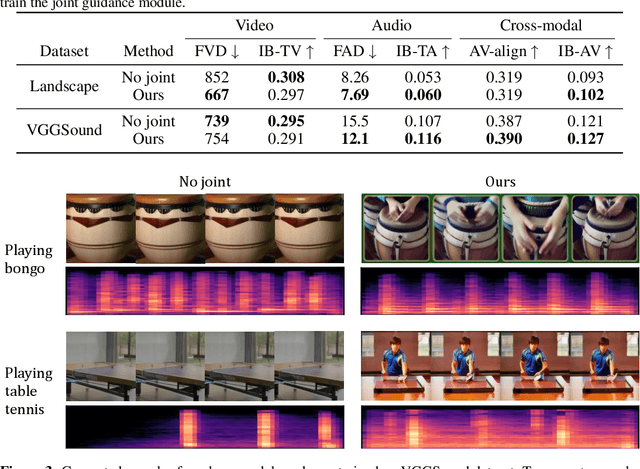
Abstract:In this study, we aim to construct an audio-video generative model with minimal computational cost by leveraging pre-trained single-modal generative models for audio and video. To achieve this, we propose a novel method that guides each single-modal model to cooperatively generate well-aligned samples across modalities. Specifically, given two pre-trained base diffusion models, we train a lightweight joint guidance module to adjust scores separately estimated by the base models to match the score of joint distribution over audio and video. We theoretically show that this guidance can be computed through the gradient of the optimal discriminator distinguishing real audio-video pairs from fake ones independently generated by the base models. On the basis of this analysis, we construct the joint guidance module by training this discriminator. Additionally, we adopt a loss function to make the gradient of the discriminator work as a noise estimator, as in standard diffusion models, stabilizing the gradient of the discriminator. Empirical evaluations on several benchmark datasets demonstrate that our method improves both single-modal fidelity and multi-modal alignment with a relatively small number of parameters.
Instruct 3D-to-3D: Text Instruction Guided 3D-to-3D conversion
Mar 28, 2023Abstract:We propose a high-quality 3D-to-3D conversion method, Instruct 3D-to-3D. Our method is designed for a novel task, which is to convert a given 3D scene to another scene according to text instructions. Instruct 3D-to-3D applies pretrained Image-to-Image diffusion models for 3D-to-3D conversion. This enables the likelihood maximization of each viewpoint image and high-quality 3D generation. In addition, our proposed method explicitly inputs the source 3D scene as a condition, which enhances 3D consistency and controllability of how much of the source 3D scene structure is reflected. We also propose dynamic scaling, which allows the intensity of the geometry transformation to be adjusted. We performed quantitative and qualitative evaluations and showed that our proposed method achieves higher quality 3D-to-3D conversions than baseline methods.
Fine-grained Image Editing by Pixel-wise Guidance Using Diffusion Models
Dec 08, 2022



Abstract:Generative models, particularly GANs, have been utilized for image editing. Although GAN-based methods perform well on generating reasonable contents aligned with the user's intentions, they struggle to strictly preserve the contents outside the editing region. To address this issue, we use diffusion models instead of GANs and propose a novel image-editing method, based on pixel-wise guidance. Specifically, we first train pixel-classifiers with few annotated data and then estimate the semantic segmentation map of a target image. Users then manipulate the map to instruct how the image is to be edited. The diffusion model generates an edited image via guidance by pixel-wise classifiers, such that the resultant image aligns with the manipulated map. As the guidance is conducted pixel-wise, the proposed method can create reasonable contents in the editing region while preserving the contents outside this region. The experimental results validate the advantages of the proposed method both quantitatively and qualitatively.
Neural Network Libraries: A Deep Learning Framework Designed from Engineers' Perspectives
Feb 12, 2021

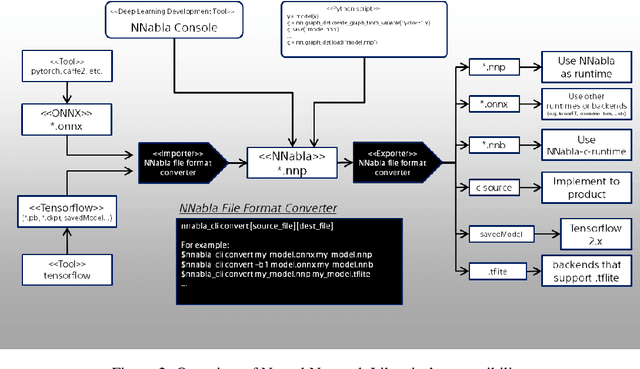

Abstract:While there exist a plethora of deep learning tools and frameworks, the fast-growing complexity of the field brings new demands and challenges, such as more flexible network design, speedy computation on distributed setting, and compatibility between different tools. In this paper, we introduce Neural Network Libraries (https://nnabla.org), a deep learning framework designed from engineer's perspective, with emphasis on usability and compatibility as its core design principles. We elaborate on each of our design principles and its merits, and validate our attempts via experiments.
 Add to Chrome
Add to Chrome Add to Firefox
Add to Firefox Add to Edge
Add to Edge